AS I walked through the wilderness of this world, I came upon a certain place where there was a den; and I lay down in that place to sleep; and as I slept I dreamed a dream…
Find the village of Harrowden, on the southern outskirts of Bedford and, if you drive West, beyond the village along a narrowing farm track, you should find Bumpy Lane. It really is the most aptly named roads you will ever come across: full of puddles and bumps and little used except for dog walkers and farm traffic. Walk along it for about 200 yards and you should see a badly weatherbeaten sign. The words “Bunyan’s Birthplace” are just about visible but very little else is. Take this path, which follows the edge of a field, full of ripened wheat on the day I went, with dragonflies zooming around me. Eventually, you will arive at a stile that leads to a clearing with a stone monolith “Birthplace of John Bunyan, 1628”. Nothing besides remains: nothing else to tell you that the area was ever inhabited. The A420 is visible, and audible, but there is nothing else to see for miles.
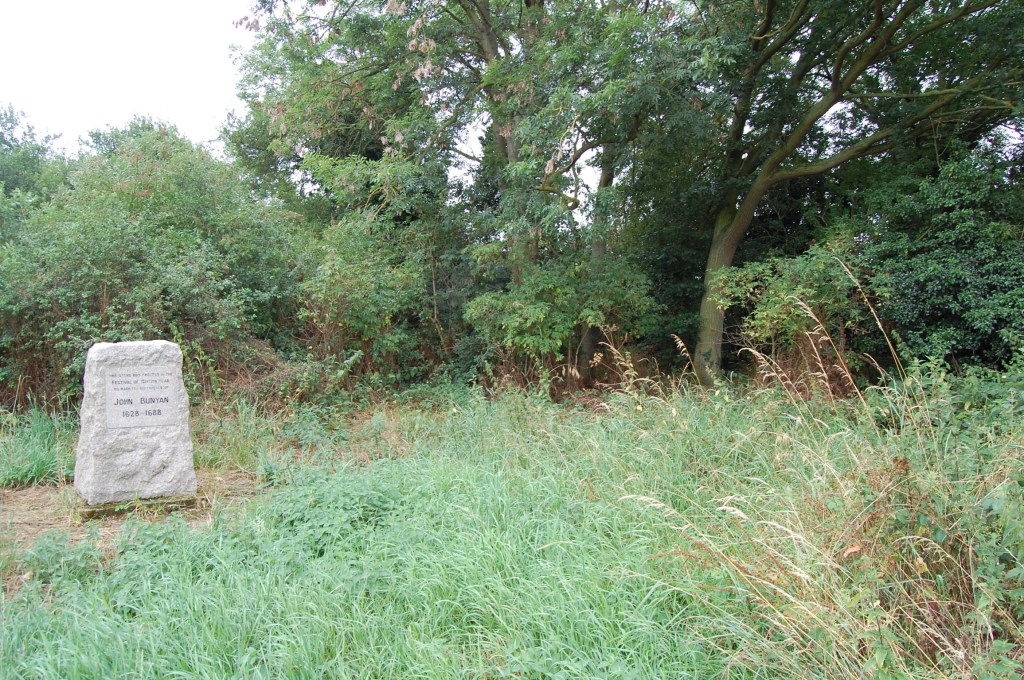
John Bunyan is one of the most important, and most interesting, writers in the English Canon. He was a preacher, rather than a writer; most of his books being based on sermons he delivered in the years following the English Civil War. He wrote one of the most important books to be written in the English language. The Pilgrim’s Progress was the second best-selling book in the English language for 350 years after its publication (until Harry Potter relegated it to 3rd) and has influenced many writers, among them CS Lewis, JRR Tolkien, Herman Melville, Charlotte Brontë, Thackeray, Dickens and Douglas Adams.
It is probably best to start your journey in Elstow, a village on the outskirts of Bedford, as it was here that his family moved, when he was an infant. It was in this village that John grew up, learning his father’s trade of tinkering. His house is no longer there; an expensive restaurant now occupies the site. In the centre of the village is the Moot Hall: a large, timber-framed building dating from the 15th Century, that houses a museum. Here you can learn about Bunyan, as well as about life in a village in the seventeenth century. Alongside exhibits about Bunyan and his life in the village, there is a collection of seventeenth century furniture and Bedfordshire lace. Friendly and extremely knowledgeable staff are on hand and happy to tell you about the village, the surrounding area and Bunyan’s life. Mrs. P and I visited this summer. It is a very pleasant, quiet village with a large green that once held a market and a charter fair; the cross is still visible, though eroded to a stump. The church is a large building, as you would expect from what was one of the largest abbeys in the country. It has a chapel dedicated to Bunyan and the font in which he was baptised.
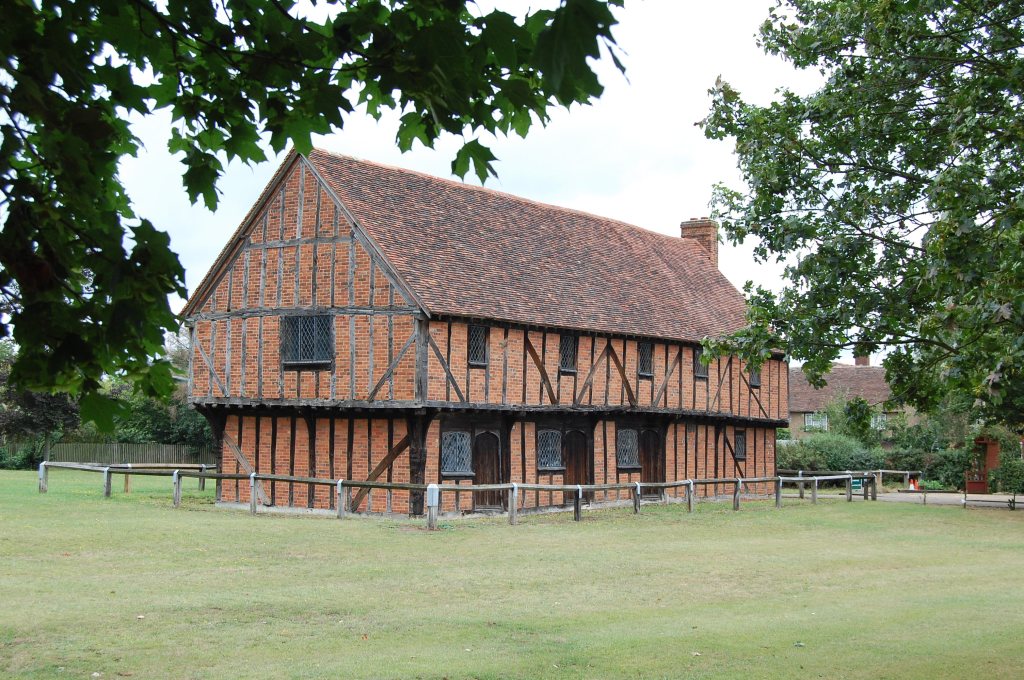
Bunyan left Elstow at the age of sixteen, when he enlisted to fight in the civil war, on the side of Parliament. He returned 3 years later and married. It was around this time that, whilst playing sport on a Sunday (‘tipcat’, according to the guide at the Bunyan Museum: a game that involves hitting a small piece of wood with a bat for some reason), in contravention of strict puritan rule, That he heard a voice speaking to him from heaven, instructing him that, if he was to enter the eternal kingdom, he had to leave his sins. He was, as you can imagine, rather perturbed by this experience and spent the next few days in confusion. When travelling through Bedford, he overheard a group of women discussing spirituality and realised that he had to join them. They were members of the Bedford Meeting and he made such an impression on them that they insisted he preach there. So his new path was set before him. He moved his family to Bedford to be close to the Meeting house where he regularly preached, building a following among the people of the town.
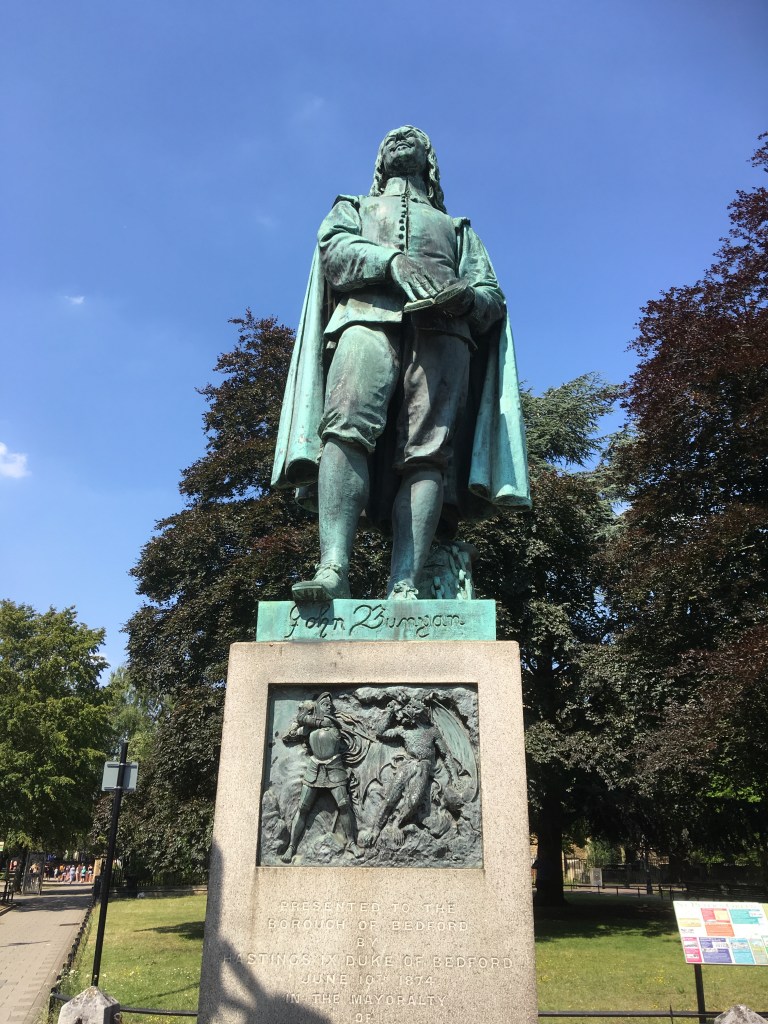
The town of Bedford certainly makes the most of its connection with Bunyan: you will find John Bunyan schools, a Bunyan playgroup and the John Bunyan health and fitness centre. The pleasure boat that cruises the navigable section of the River Ouse is called the John Bunyan and there is a pub called the Pilgrim’s Progress. None of these has any connection with Bunyan but you can see the church in which he preached, and the small museum dedicated to him. You can also walk across the bridge and see the small inlet of the Ouse in which he was allegedly baptised.
The Bunyan Museum and Library is a great little museum with a collection of artefacts relating to Bunyan and his life and times in the area. You can see the door of his cell, his pulpit and a number of other possessions: A tin violin he made during his time as a tinker, a stone water jug he used whilst in prison. There is also a magnificent carved wood depiction of Christian’s fight with Apollyon and a bookcase full of translations of Pilgrim’s Progress. 170 languages no less! plus editions of some of his sixty other books. The staff were incredibly friendly and chatty and very keen to show me around. We chatted about literature and Bunyan and they shared the benefit of their extensive knowledge of the man and his history. They let me have a look round the meeting house.It seemed to me a fine place for worship: impressive but not ostentatious, with a gallery running around three sides and a sky-blue, barrel vaulted ceiling. There is a strong emphasis on music here, with a piano and organ taking pride of place at the front of the church. The most impressive thing by far is the glass: eight beautiful and colourful windows showing scenes from The Pilgrim’s Progress.
The Pilgrim’s Progress is an allegory about the Christian Life. Within it a man, Christian, Wanders through the world in search of the ‘Celestial City’. He has a pack upon his back which slows him down but which he cannot get rid of. He encounters various characters, some of whom help him and some don’t. He passes through many places, such as the hill difficulty and the Valley of the Shadow of Death, where he slays the demon Apollyon. Some local places have been identified with the locations in Bunyan’s book. One of them, the House Beautiful, is supposed to be Houghton House at Ampthill, the ruin of an Elizabethan Manor house, now in the care of English Heritage. Mrs. P and I visited on a very fine summer afternoon. It commands a wonderful view over Bedfordshire. The house is a ruin: gutted when the Duke of Bedford had the property dismantled in 1794. Some of the furniture was sold to the Swan Hotel and the staircase can still be seen in the hotel hallway. The property is managed by English Heritage and I’ve always had a lot of time for this organisation. Rather than keep children back behind ropes and barriers, they actively encourage them to explore and enjoy historical buildings. We loved taking our children to the houses and castles they care for and, at Houghton today, there were many children (and dogs) were enjoying themselves here today.
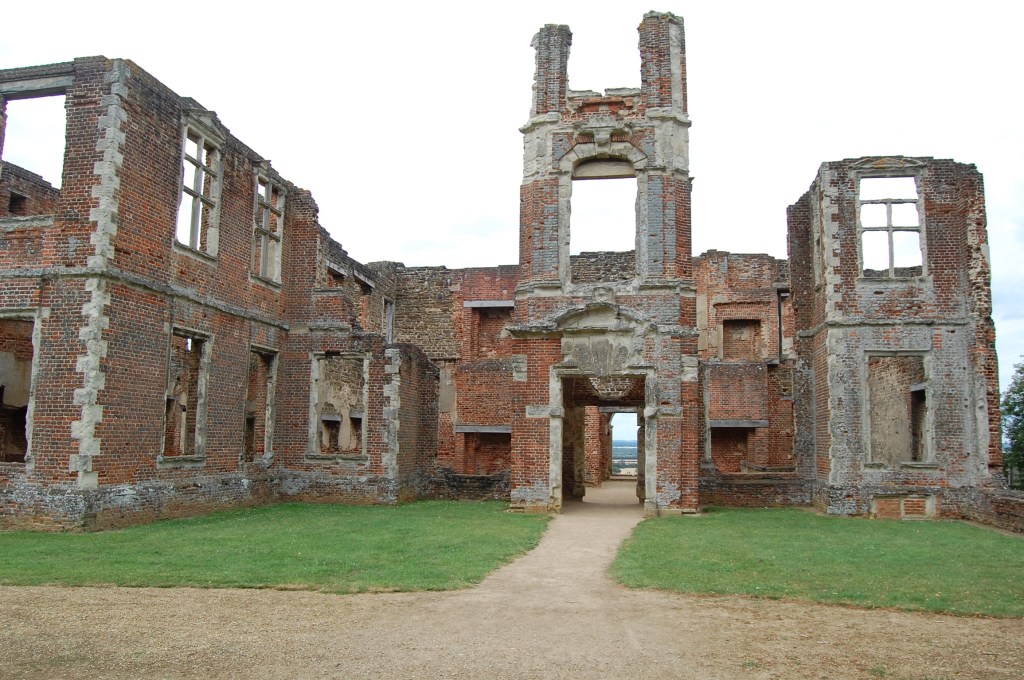
…a pleasant place, where was builded a stately palace, beautiful to behold; at the sight of which Christian was greatly delighted.
John Bunyan, the Pilgrim’s Progress
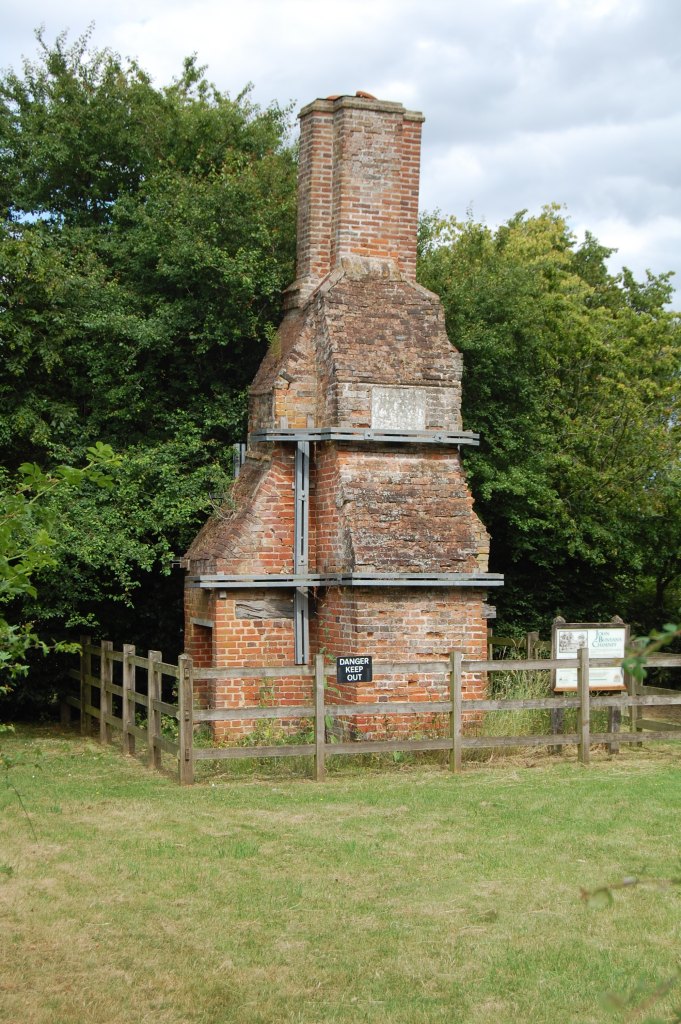
As Bunyan’s fame spread, he travelled throughout the country, preaching to assemblies of people in market places and woodland dells. There are one or two places dotted about where he is said to have preached: at the market cross in Stevington, near Bedford, and at Harlington Oak, near Luton, where he preached shortly before his arrest. In Colman Green near Hatfied, part of a ruined cottage has been named Bunyan’s chimney in commemoration of the fact that he used to preach nearby. It is a lovely area for a walk and there are some nice country footpaths lead out into the countryside from here. A pub nearby has been named the John Bunyan in honour of the Great man too. There are some churches where he is known to have preached, although none of the original buildings remains. There is one in Haynes on the outskirts of Bedford and one over the border into Cambridgeshire at Gamlingay.
Following the restoration of the monarchy in 1660, non-conformist preaching, which had been tolerated during the interregnum, was outlawed. Bunyan had to preach in out of the way places, away from the prying eyes of the authorities. One such place was at Wain Wood near Hitchin in Hertfordshire. Within this wood is a natural hollow, allowing a large crowd to see and hear a speaker. Ms. E and I discovered this wood last summer. It lies near the tiny village of Preston. I met E in the Red Lion, the first community owned pub in the country. When sold off by its brewery in 1982, it was bought and saved by the local community and is still run by them. A lovely little pub and a very good lunch. From here we walked through the lovely little village to Wain Wood. Bunyan’s cottage, the house in which he is said to have stayed, is private property and not accessible. It is still clearly visible from the path, however, which goes on to dive off into the undergrowth and, in places, disappears completely. We followed it with difficulty, frequently losing it altogether. We joked about what would happen should we get lost completely (Mr. Lingley, E’s dutiful boyfriend would come to our rescue, having located our mobile ‘phone signals, we concluded. Mrs. P would not notice my absence for several months and, even then, may decide against coming to my aid)
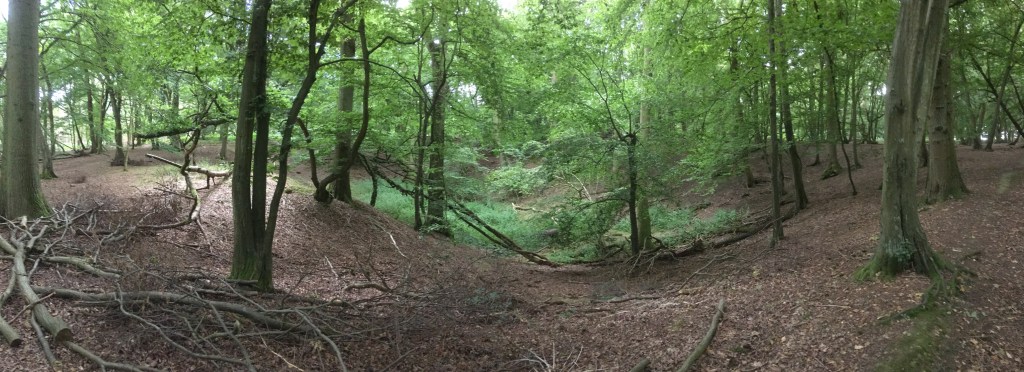
Eventually, we stumbled across a hollow in the floor of the wood and stopped to take a look around. It is overgrown now and trees have grown up in the space where Bunyan once preached. It has also been used as a rubbish dump and, sadly, there was an old oil drum in the hollow, along with a fair proportion of barbed wire. It was still possible to imagine a crowd gathering for a meeting and a story here. We tried reciting some Pilgrim’s Progress here: the acoustics were unremarkable; there was nothing particularly spiritual or holy about the place. it was a clearing in a wood. Just as we were discussing this; the sky suddenly darkened. The effect was so profound that we stopped and looked at each other; it was a weird change in the light that we weren’t expecting. It had been a pleasant August day when we left the pub, not blazing sunshine but bright and warm – good walking weather. Presently the heavens opened and the deluge was unleashed, it rained solidly and heavily for a good ten minutes while we sheltered beneath the trees. And then, as quickly as it had started, it departed and left us to wander back to the village in bright sunshine.
Throughout the 70’s and 80’s, Bunyan lived his life writing and preaching, in church and out of it. In 1688 Bunyan went to visit a friend, who had invited him to preach in Petticoat Lane. He arrived in a rainstorm and, despite his obvious illness, insisted on going on with the service. On returning to his friend’s house, his condition worsened and he died a few days later. He is buried in Bunhill Fields, a graveyard in Moorgate, reserved for dissenters. His memorial can be seen there now, alongside that of William Blake and Daniel Defoe.
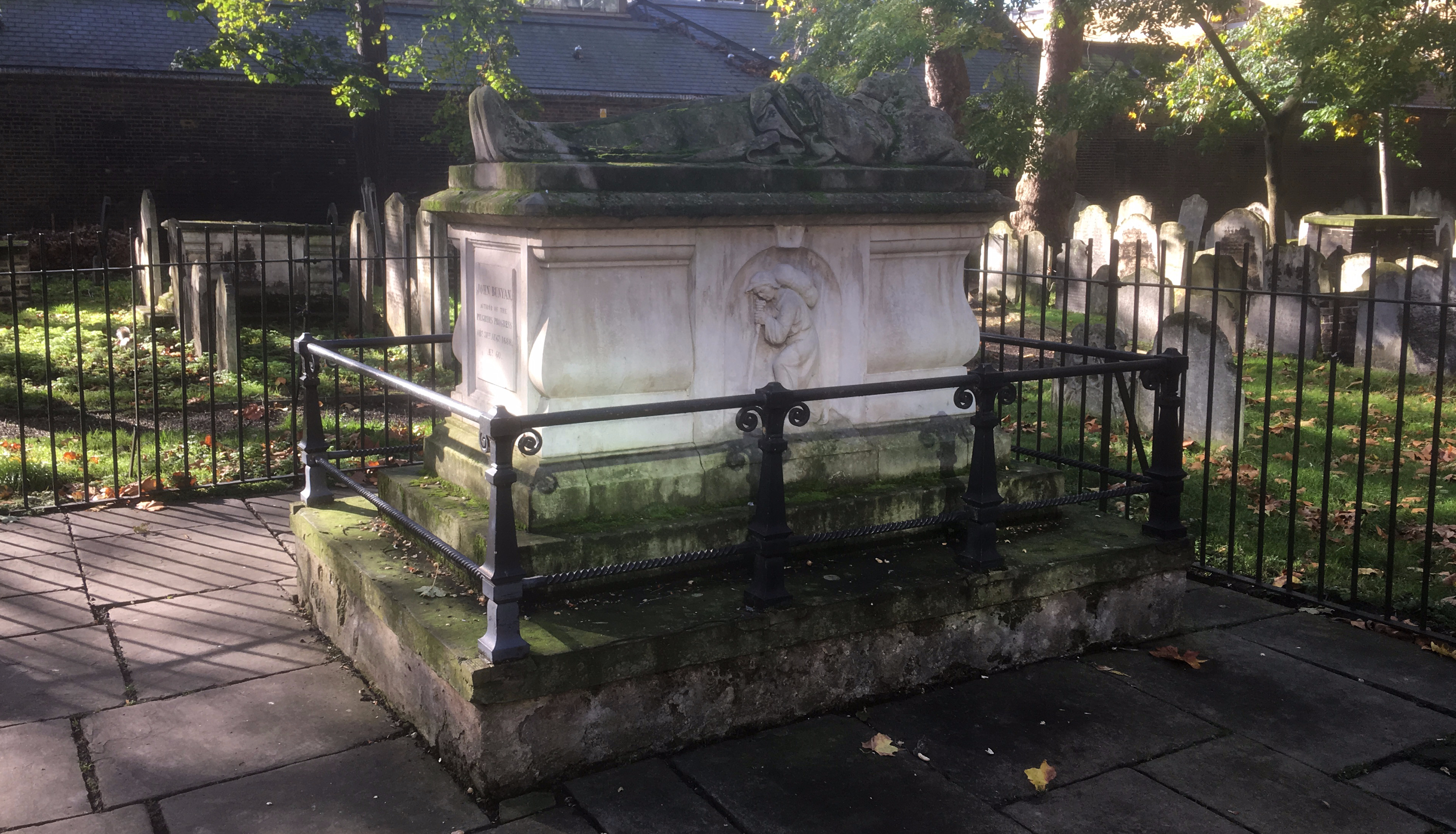

Leave a comment